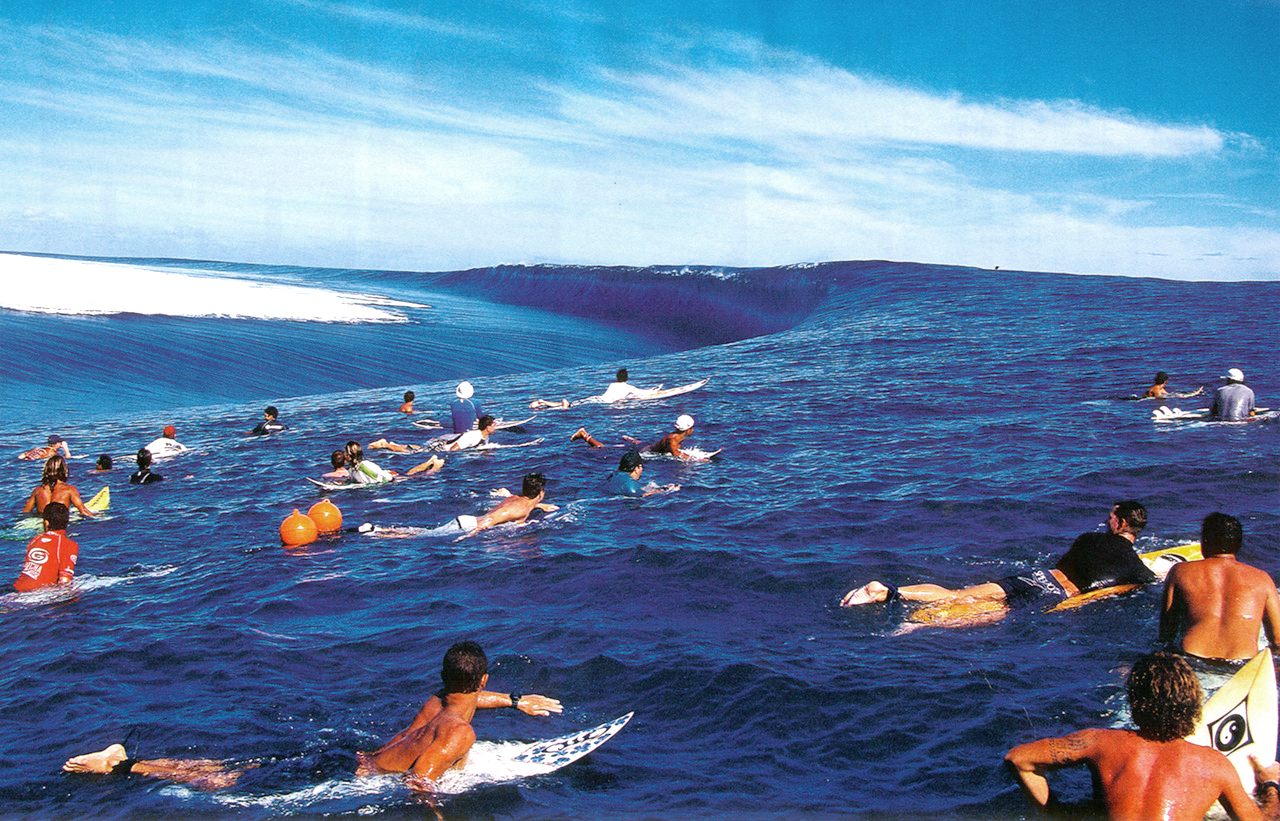Teahupoo. How Do You Say That? What Does It Mean?
In case you have never seen the awesome wave of Teahupoo, here is a video.
The amazing Laird Hamilton rides the famous giant wave of Tahiti. Immediately, people started calling it “the greatest/largest/highest/biggest wave ever ridden!” in a quest for view count spectacular.

Fact is, the wave at Teahupoo is amazing in many respects. Still, it’s not the biggest wave by far, not even the biggest surf-friendly wave, nor the biggest wave surfed. But it has certain qualities that endear it to the camera (more than to the surfer).
For one, it is located at a shallow reef right next to a deep channel. That makes it possible for camera crews and rescue boats to sit right next to the breaking wave for an almost perfect shot. Indeed, the first time I saw the swell at Teahupoo was on a poster where about a dozen boardshorted surfers sit next to a wall of water that looks 100 foot high – without batting an eye, indicating that they knew the wave was not going to hit them.
The conditions are frequently perfect for shots. The waters of Tahiti are relatively calm, and the swell originates far, far away, in the freezing waters of the Antarctic Ocean. When they get to Teahupoo, they are monstruous, but they lost all the misshapenness of their origin. The lower frequencies dissipate, only the big carrier wave makes it to Polynesia.
All but one thing stymies the Teahupoo enthusiast: how on earth do you pronounce the name? And, secondarily, what does that mean?
Spelling
The first point to make is that the correct spelling of the word is, Teahupoo*. The little mark, the *okina, is Polynesia’s way of marking what is called a glottal stop. That’s when you pause between two vowels instead of fusing them together.
Pronunciation
Once we agree on the correct spelling, we figure out easily how to correctly pronounce the word. While the consonants sound pretty much the same in English and Polynesian languages, the vowels are totally different. They sound a lot more like Spanish, or most languages written with the Latin alphabet (including Latin, but excluding English and French).
In particular, the “ea” that marks the first syllable in the word is pronounced like English “pear,” the fruit, not like in English “spear,” the lance. The “u” that follows is pronounced like English “oo”, while the “o`o” at the end is pronounced like English “oh-oh!” Yes, that was a surprise.
Note that the Polynesian “T” became “K” in Hawaiian. Indeed, the T is a very hard one, more like a British “T” than an American one. Try saying T-K-T-K-T-K (just the sound, not the name of the letter) in quick succession, and you’ll eventually end up with the hard Polynesian T.
So, to put it all together, the correct pronunciation is: tear-hoo-poh-oh
(Where “tear” is the verb, as in “to tear apart”)
Mispronunciation
You’ll often hear a horrible mispronunciation: Chopoo. That’s a fairly common one, and is typical of people that haven’t had much exposure to Polynesian. Some people make fun of it (and of the surfers that brave the wave) by modifying it slightly to “chew poo,” which is presumably what you’d do after getting hit on the head by a barrel.
Notice that Polynesian doesn’t have the sound “ch” at all, making this a very strange pronunciation. Notice also that most places in Polynesia have names that are fairly descriptive. Finally, notice that the initial “Te” is the Tahitian definite article (“the” in English), which is always pronounced as mentioned above.
Meaning
Ahu and po`o are fairly common words in Polynesian, making a reconstruction of the meaning fairly easy. Regardless, nouns are fairly fluid in Polynesian languages, and even though we may know the exact words used, we may not exactly know the connotation.
Ahu generally means “heap, pile.” It can also mean a series of things related to heaps and piles, as in “heap, pile, collection, mound, mass; altar, shrine, cairn; a traplike stone enclosure.”
Po`o generally means “head.” It can also mean a lot of head-like things, like “head, summit, head or director of an organization, executive, principal; end, as of a rope, leaf, pole, cane, kōnane board; head of a penis or boil; headline, heading, title; father (see poʻo lua, poʻo ʻole); hair in such expressions as poʻo hina, poʻo kea (preceded by ke)”
You could see a ton of different things in there. But we’ll go for the main meaning. Teahupo`o then means the pile of heads.
I should note that, as often the case, there is a much more obvious and boring meaning: Teahupo`o is the end of the road in Tahiti Iti, and as mentioned the last part of the word can just mean “end (of a rope)” or something long. This more obvious and boring meaning would then be, “the place at the end of the road.”
Legend
There is a local legend (as reported on different sites) that Teahupo`o was a fishing village that emerged victorious in one of those incredibly brutal wars between tribes in Tahiti. To mark the victory, they decapitated the slain warriors and piled the heads in one spot.
Hard to tell whether the legend came after or before the place was named Pile of Heads, though. Especially because it might well not be about a pile of heads after all.
Geography
According to most sites I visited, Teahupo`o refers only to the village that is the end of the road by the break. The reef channel is apparently called Havae, while the break/wave is called Pererure.
There you have it!